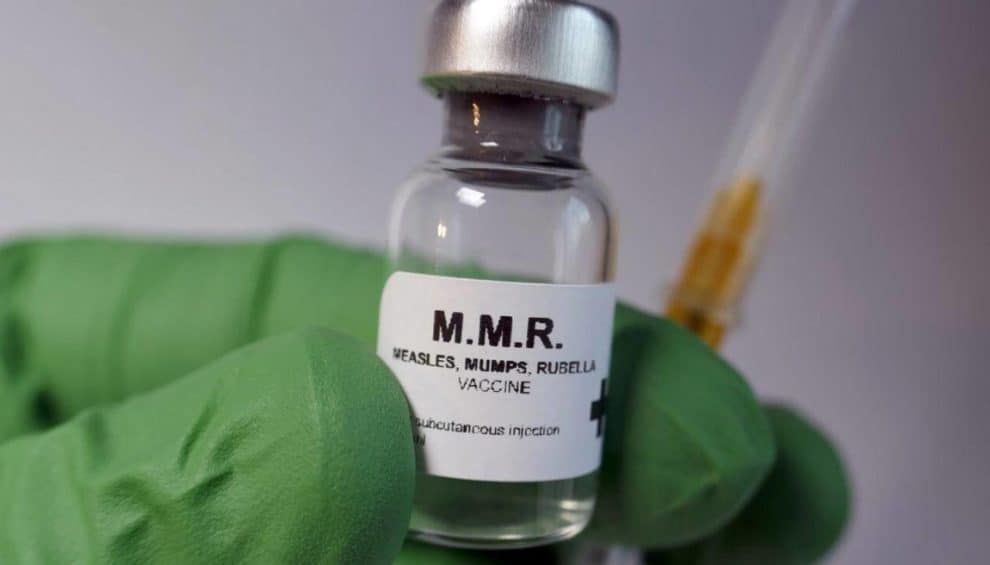
- Measles vaccination virtually eliminates any chance of contracting the disease.
- Childhood immunization rates have remained at a consistent level for the past 20 years.
- Despite recent media hysteria there’s little evidence of a ‘measles comeback’.
The mainstream media and in some cases politicians and government officials are fanning the flames of hysteria over several ‘hotspots’ of measles outbreak across the United States. Some breathless reports are even suggesting that the country is at risk of a ‘measles comeback’ in which a disease that has been considered eradicated once again becomes a factor. A subtext of this narrative is that the ‘outbreak’ (some media outlets use the term ‘epidemic’ incorrectly) is due to lower vaccination rates caused by an increase in ‘anti-vaccine’ conspiracy theorists known colloquially as anti-vaxers. With World Immunization Week taking place in the last week of April it seems like a perfect time to put some of the aforementioned narratives to the test to see if they withstand statistical scrutiny.
THE MEASLES VACCINE IS EFFECTIVE
Numbers don’t lie. You don’t need to do anything more to validate the effectiveness of the measles vaccine (more properly known as the MMR vaccination covering measles, mumps and rubella) beyond looking at reported cases in the United States from year to year. The first measles vaccine was tested in the late 1950s. At the time, estimates are that there were several million cases a year in the United States though only around 500,000 were reported to the Center for Disease Control (CDC). The development of a measles vaccine had incremental success with the first somewhat effective one licensed in 1963. An updated version came online in 1968 and the ‘MMR vaccine’ was first developed in 1971. Now take a look at the rate of reported measles cases year by year:
New Measles Cases in the United States by Year
| 1950 | 319,124 | |
| 1960 | 441,703 | |
| 1970 | 47,351 | |
| 1980 | 13,506 | |
| 1990 | 27,786 | |
| 2000 | 86 | |
| 2005 | 66 | |
| 2010 | 63 | |
| 2015 | 188 | |
| 2018 | 372 |
There may be some ancillary factors in the dramatic decline in new measles cases including heightened awareness and education. On the other hand, there are several countervailing trends that theoretically should have resulted in an increase in measles cases such as more effective reporting methods and a US population increasing in size and diversity. The effectiveness rate quoted frequently ranges from 93% to 97% and based on the data that appears to be accurate.
WHAT ARE THE CHANCES OF CONTRACTING MEASLES?
I love converting probabilities into moneylines but that’s difficult to do with this ‘proposition’. Vaccinated or not, your odds of catching measles is minuscule as in a fraction of 1%. You’ve got a better chance of catching measles than you do winning the Powerball lottery jackpot but for a vaccinated individual it is significantly less than your chance of dying from a flesh eating virus. Your chance of just contracting a flesh eating virus is 1 in 30,000. Compare that to your chance of contracting measles based on 2018 data:
VACCINATED: 1 IN 2.5 MILLION
NOT VACCINATED: 1 IN 450 THOUSAND
Calculations based on data from the Center for Disease Control
This year there have been 465 cases of measles reported as of April 4, 2019. Even if this number should double or triple the chance of catching measles is statistically insignificant.
These are very general probabilities but we need a big disclaimer here–your actual chance of contracting measles is subject to a number of variables including overall health, age, lifestyle, etc. The diseases most often spreads in communities with greater exposure due to international travel and lower vaccination rates. More about that in a moment. If you look at the new measles cases data above and the CDC chart linked above you’ll see why its tough to buy that measles is making a ‘comeback’. The number of new cases frequently spikes in a given year but returns to an extremely low number the following year. For example, in 2014 there were 667 new cases but only 188 in 2015 and 86 in 2016. Is it possible that the rate of new measles cases could continue to rise? Sure it is–but to even suggest that a disease considered ‘eradicated’ is making a comeback would require a big jump to a statistically significant level for at least several years.
HAS THE VACCINATION RATE EXPERIENCED A SUBSTANTIAL DROP?
Based on the statistics it sure doesn’t look like it. To put it into a ‘probability’ format there’s a 1 in 1.1 chance that a child under the age of 36 months has been vaccinated. The actual rate varies from state to state and even county to county. The state level vaccination rate ranges from a low of 85.8% (Missouri) to a high of 98.3% (Massachusetts). What’s interesting is that no matter what the vaccination rate might be in an individual state it has remained essentially unchanged for the past twenty years. For example, the red line reflects the vaccination rate in Massachusetts from 1996 to 2017:

And in this graph the red line represents the vaccination rate in Missouri from 1996 to 2017:

In both cases, you’re looking at what is pretty much a straight line. In other words, there hasn’t been a significant change in the vaccination rate in these states and that’s the case in every other state. If you want to play with the data yourself or check out your state you can do it here:
CDC VACCINATION COVERAGE INTERACTIVE DATA
DON’T CHILDREN HAVE TO HAVE A MEASLES VACCINE TO START SCHOOL?
All 50 states and the District of Columbia have a law requiring children to have certain vaccines–including the MMR vaccine–before they’re allowed to attend public school. And what if the parents don’t want to vaccinate their children? In most cases, they don’t have to. Every state has a ‘medical exemption’. No problem there–if a doctor has a compelling reason why a child shouldn’t be vaccinated it should be honored. Here’s the problem–47 states and the District of Columbia have a religious exemption from the vaccination requirement. In most states, all a parent needs to do is sign a written statement affirming that it violates their religious beliefs to have their child vaccinated. 17 states and the District of Columbia have a philosophical exemption meaning that a parent can pretty much not vaccinate their kid for any reason.
You may be wondering if this loophole big enough to drive a semi truck through is a contributing factor in measles outbreaks. The CDC sure thinks so–for example, here’s their analysis of the 2018 outbreaks:
“The U.S. experienced 17 outbreaks in 2018. Three outbreaks in New York State, New York City, and New Jersey, respectively, contributed to most of the cases. Cases in those states occurred primarily among unvaccinated people in Orthodox Jewish communities. These outbreaks were associated with travelers who brought measles back from Israel, where a large outbreak is occurring. Eighty-two people brought measles to the U.S. from other countries in 2018. This is the greatest number of imported cases since measles was eliminated from the U.S. in 2000.”
That is a recurring theme in every recent measles outbreak. They’re all centered around small groups of unvaccinated people–typically religious groups. If you want to read more you can do so at the link below:
CDC MEASLES CASES AND OUTBREAKS DATA
WHAT ABOUT THE ANTI-VAXXERS?
I’ll preface this section by saying that I’ve yet to hear a compelling argument for why you shouldn’t vaccinate your children. That being said–and based on the data discussed in the previous sections–it looks like the ‘increase in anti-vaxxer sentiment’ has no statistical validation. People have a right to their opinion, even if its wrong. The anti-vaxxers might be more visible now for the same reason that every fringe group is more visible now–the ease of creating content and disseminating it on the Internet. It just doesn’t look as if they’ve moved the needle on vaccination rates even in states where they’re supposed to have a significant presence. They are, however, a convenient scapegoat for politicians like the unctuous New York City Mayor Bill DiBlasio:
De Blasio decried anti-vaxxer misinformation campaigns targeting parents, and the health commissioner warned parents were having “measles parties” to infect their children with measles and to naturally immunize them — and avoid the vaccination.
Going after anti-vaxxers doesn’t have the same degree of political risk as targeting a specific religion. Given the reaction within the Orthodox Jewish community it’s easy to understand why DiBlasio doesn’t want to touch the religious exemption issue with a ten foot pole. Instead, he’d rather disingenuously blame a less politically connected group since that’s his forte. Unfortunately, the mainstream media–particularly outlets that carry water for DiBlasio such as the New York Times–are blaming anti-vaxxers for the failure of religious communities to vaccinate their children. The anti-vaxxers don’t need to target religious groups that don’t believe in vaccinations–their religious doctrine did the work for them years ago.
To be fair, there are definite constitutional arguments in favor of religious exemptions in general and in the current situation with the Orthodox Jewish community in New York in particular. At what point does adhering to religious beliefs become a public health hazard? Is it justifiable to deny people religious freedom once that threshold is reached? If an outbreak occurs within insular religious groups is that a problem for the public at large? The CDC has a very low threshold for an ‘outbreak’–four or more reported cases. From a practical standpoint, however, even a few hundred cases is statistically insignificant.
CONCLUSION
Here’s the good news–despite media and political hysterics to the contrary there’s scant evidence that measles are making a ‘comeback’. Furthermore, the current number of reported measles cases might be higher than usual but their not unprecedented within the context of the year to year data. Most people–vaccinated or unvaccinated–are at minimal risk of contracting measles. Unless you check several boxes such as religious beliefs, international travel to certain countries and not being vaccinated you’re more likely to be mauled by bears in your front yard than you are to catch measles. Unfortunately, that hasn’t stopped the media from fanning the hysteria and some politicians from trying to exploit the situation. The fact they’ve got a viable scapegoat in the anti-vaxxers means they won’t have to take the political risk of going after any specific religious groups.









